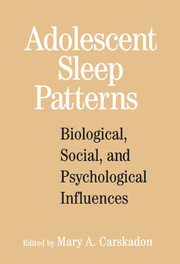Book contents
- Frontmatter
- Contents
- List of Contributors
- Foreword
- Preface
- Adolescent Sleep Patterns
- 1 Sleep and Adolescence: A Social Psychologist's Perspective
- 2 Factors Influencing Sleep Patterns of Adolescents
- 3 Endocrine Changes Associated with Puberty and Adolescence
- 4 Maturational Changes in Sleep-Wake Timing: Longitudinal Studies of the Circadian Activity Rhythm of a Diurnal Rodent
- 5 Nutrition and Circadian Activity Offset in Adolescent Rhesus Monkeys
- 6 Toward a Comparative Developmental Ecology of Human Sleep
- 7 Sleep Patterns of High School Students Living in São Paulo, Brazil
- 8 Sleep Patterns and Daytime Function in Adolescence: An Epidemiological Survey of an Italian High School Student Sample
- 9 Risks of Driving While Sleepy in Adolescents and Young Adults
- 10 What Can the Study of Work Scheduling Tell Us about Adolescent Sleep?
- 11 Accommodating the Sleep Patterns of Adolescents within Current Educational Structures: An Uncharted Path
- 12 Bridging the Gap between Research and Practice: What Will Adolescents' Sleep-Wake Patterns Look Like in the 21st Century?
- 13 Influence of Irregular Sleep Patterns on Waking Behavior
- 14 Stress and Sleep in Adolescence: A Clinical-Developmental Perspective
- 15 The Search for Vulnerability Signatures for Depression in High-Risk Adolescents: Mechanisms and Significance
- 16 The Regulation of Sleep-Arousal, Affect, and Attention in Adolescence: Some Questions and Speculations
- Index
- References
4 - Maturational Changes in Sleep-Wake Timing: Longitudinal Studies of the Circadian Activity Rhythm of a Diurnal Rodent
Published online by Cambridge University Press: 22 September 2009
- Frontmatter
- Contents
- List of Contributors
- Foreword
- Preface
- Adolescent Sleep Patterns
- 1 Sleep and Adolescence: A Social Psychologist's Perspective
- 2 Factors Influencing Sleep Patterns of Adolescents
- 3 Endocrine Changes Associated with Puberty and Adolescence
- 4 Maturational Changes in Sleep-Wake Timing: Longitudinal Studies of the Circadian Activity Rhythm of a Diurnal Rodent
- 5 Nutrition and Circadian Activity Offset in Adolescent Rhesus Monkeys
- 6 Toward a Comparative Developmental Ecology of Human Sleep
- 7 Sleep Patterns of High School Students Living in São Paulo, Brazil
- 8 Sleep Patterns and Daytime Function in Adolescence: An Epidemiological Survey of an Italian High School Student Sample
- 9 Risks of Driving While Sleepy in Adolescents and Young Adults
- 10 What Can the Study of Work Scheduling Tell Us about Adolescent Sleep?
- 11 Accommodating the Sleep Patterns of Adolescents within Current Educational Structures: An Uncharted Path
- 12 Bridging the Gap between Research and Practice: What Will Adolescents' Sleep-Wake Patterns Look Like in the 21st Century?
- 13 Influence of Irregular Sleep Patterns on Waking Behavior
- 14 Stress and Sleep in Adolescence: A Clinical-Developmental Perspective
- 15 The Search for Vulnerability Signatures for Depression in High-Risk Adolescents: Mechanisms and Significance
- 16 The Regulation of Sleep-Arousal, Affect, and Attention in Adolescence: Some Questions and Speculations
- Index
- References
Summary
In addition to the maturation of endocrine and reproductive systems, puberty in human adolescents is associated with changes in the temporal patterns of several physiological and behavioral events. One of the most prominent behavioral changes is an alteration in sleep organization, specifically a delay in the timing of nocturnal sleep (Strauch & Meier, 1988; Carskadon, Vieira, & Acebo, 1993). Epidemiologic data demonstrate that length of nocturnal sleep declines across adolescence. Most older teenagers report that their sleep patterns on weekdays have an increasingly delayed time of sleep onset, yet they are constrained to wake up early due to school demands. On weekends, when school constraints are not present, sleep onset and sleep offset are delayed. This adolescent delay of the sleep-wake schedule is also associated with a more evening-type preference (Andrade, Benedito-Silva, & Menna-Barreto, 1992; Carskadon et al., 1993).
Although social factors are clearly important in the evolving sleep-wake pattern of adolescents, available evidence implicates peripubertal changes in physiologic mechanisms controlling the timing of sleep. Current models of these mechanisms allow two broad hypotheses: either the circadian system regulating sleep timing is altered to produce a delayed entrained phase position, or homeostatic processes are changed to delay sleep times relative to the circadian oscillator (Borbely, Achermann, Trachsel, & Tobler, 1989). This latter hypothesis remains largely unexplored and is not addressed here.
- Type
- Chapter
- Information
- Adolescent Sleep PatternsBiological, Social, and Psychological Influences, pp. 40 - 49Publisher: Cambridge University PressPrint publication year: 2002
References
- 3
- Cited by

